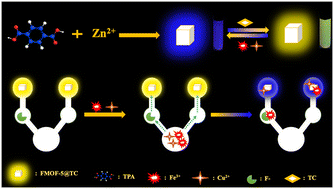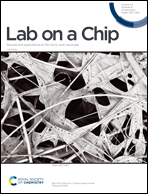A novel ratiometric design of microfluidic paper-based analytical device for the simultaneous detection of Cu2+ and Fe3+ in drinking water using a fluorescent MOF@tetracycline nanocomposite
Abstract
The regular and on-site monitoring of ions in drinking water is essential for safeguarding public health, ensuring high water quality, and preserving the ecological balance of aquatic ecosystems. Thus, developing a portable analytical device for the rapid, cost-effective, and visual on-site detection of multiple environmental pollutants is notably significant. In the present work, a novel ratiometric microfluidic paper-based analytical device (μPAD) was designed and developed for the simultaneous detection of Fe3+ and Cu2+ ions in water samples taking advantages from built-in masking zone. The μPAD was functionalized with a greenish-yellow fluorescent Zn-based metal–organic framework@tetracycline (FMOF-5@TC) nanocomposite, and the ratiometric design was based on the change in emission color from greenish yellow (FMOF-5@TC) to blue (FMOF-5). The μPAD consisted of one sample zone linked to two detection zones via two channels: the first channel was for the detection of both ions, while the second was intended for detecting only Cu2+ ions and comprised a built-in masking zone to remove Fe3+ ions prior to reaching the detection zone. The corresponding color changes were recorded with the aid of a smartphone and RGB calculations. The linear ranges were 0.1–80 μM for Cu2+ and 0.2–160 μM for Fe3+, with limits of detection of 0.027 and 0.019 μM, respectively. The simple μPAD design enabled the simultaneous detection of Cu2+ and Fe3+ ions in drinking water samples with excellent accuracy and precision, with spike recoveries of 81.28–96.36% and 83.01–102.33% for Cu2+ and Fe3+, respectively.



 Please wait while we load your content...
Please wait while we load your content...